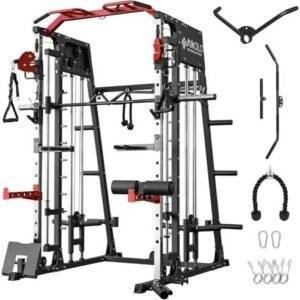Introduction
In the ever-evolving landscape of sports, the pursuit of peak athletic performance has transcended traditional training methodologies, giving way to a more sophisticated and data-driven approach. Athletes, coaches, and sports scientists alike recognize that optimizing athletic potential requires a holistic framework that encompasses not only physical conditioning but also mental resilience, nutritional strategy, and recovery protocols. This article delves into the intricacies of developing a comprehensive sports performance training program designed to unlock an athlete’s full capabilities.
From the foundational principles of biomechanics to advanced techniques in strength and conditioning, we will explore evidence-based strategies tailored to the unique needs of individual athletes across various disciplines. By integrating cutting-edge technologies such as wearables and performance analytics, this program aims to track progress and make informed adjustments to training regimens. Additionally, we will examine the critical role of interdisciplinary collaboration, where fitness professionals, nutritionists, and psychologists work in concert to create a supportive environment that fosters peak performance.
As we venture into the specifics of optimizing athletic potential, this article will provide valuable insights into goal setting, exercise selection, and program periodization, ensuring that athletes not only achieve their performance objectives but also minimize the risk of injury and burnout. Whether for seasoned competitors or aspiring athletes, the principles discussed herein will serve as a foundation for a personalized approach to sports performance training, ultimately leading to enhanced results, longevity in sport, and a deeper understanding of what it truly means to push the limits of human performance.
Table of Contents
- Enhancing Physical Conditioning Through Targeted Training Regimens
- Incorporating Nutritional Strategies for Optimal Performance Fueling
- Psychological Elements: Building Mental Resilience in Athletes
- Utilizing Technology and Data for Performance Tracking and Improvement
- In Retrospect
Enhancing Physical Conditioning Through Targeted Training Regimens
To achieve peak athletic performance, athletes must engage in tailored training regimens that target specific aspects of physical conditioning. By integrating different training modalities, sports professionals can enhance their strength, endurance, speed, and agility. A well-structured program includes:
- Strength Training: Focus on compound movements to build overall power.
- Endurance Workouts: Incorporate steady-state cardio and high-intensity interval training (HIIT) for stamina.
- Speed and Agility Drills: Use techniques such as plyometric exercises to improve reaction time and quickness.
- Flexibility and Recovery Protocols: Implement dynamic stretching and mobility work to enhance muscle recovery and prevent injuries.
Moreover, a data-driven approach allows for continuous improvement in training specificity. Athletes should track their performance metrics and adjust their regimen accordingly. One effective strategy involves the use of periodization in training cycles, which allows for:
| Cycle Phase | Focus Area | Duration (Weeks) |
|---|---|---|
| Preparation | Building Base Strength | 4 |
| Strength | Maximal Strength Development | 3 |
| Power | Explosive Strength and Speed | 3 |
| Competition | Sport-Specific Mastery | 2 |
This structured approach not only keeps training varied and engaging but also ensures that athletes are prepared to meet the demands of their competitive season with optimal performance levels. Tailoring training programs based on individual athlete assessments creates a roadmap for success, pushing boundaries and maximizing potential in every facet of their conditioning journey.
Incorporating Nutritional Strategies for Optimal Performance Fueling
To enhance athletic performance, strategic nutritional choices are essential. Athletes should prioritize a well-balanced diet that is tailored to their specific training regimens and performance goals. Key components of this nutritional strategy include:
- Carbohydrates: The primary fuel source, essential for sustained energy during training and competition.
- Proteins: Vital for muscle repair and growth, aiding recovery after intense workouts.
- Fats: Necessary for long-duration energy and promoting overall health.
- Hydration: Critical for maintaining performance levels and preventing fatigue and cramps.
- Micronutrients: Vitamins and minerals that support metabolic processes and immune function.
To better understand the impact of nutrition on performance, athletes can utilize a sample meal plan designed for optimal fueling. This plan can be adjusted based on individual calorie needs, activity levels, and personal preferences:
| Meal | Foods |
|---|---|
| Breakfast | Oatmeal with fruit and nuts, Greek yogurt |
| Lunch | Grilled chicken, quinoa, steamed vegetables |
| Snacks | Protein bars, smoothies, mixed nuts |
| Dinner | Baked salmon, brown rice, salad |
This structured approach to nutrition not only fuels workouts but also accelerates recovery, allowing athletes to train harder and perform better consistently. By adopting these nutritional strategies, athletes can maximize their training outcomes and overall athletic potential.
Psychological Elements: Building Mental Resilience in Athletes
Building mental resilience is a crucial component in optimizing athletic performance. Athletes often face various pressures, whether it’s competing at a high level, recovering from injuries, or handling the ups and downs of training. To navigate these challenges effectively, athletes can adopt several psychological strategies:
- Visualization Techniques: Athletes can enhance their performance by visualizing successful outcomes, training routines, and even how to handle unexpected situations during competitions.
- Mindfulness Practices: Incorporating mindfulness into training helps athletes stay present, reducing anxiety and improving focus during critical moments in events.
- Positive Self-Talk: Encouraging oneself through positive affirmations can counteract self-doubt and enhance confidence before and during competitions.
- Goal Setting: Establishing clear, measurable, and attainable goals promotes motivation and provides a roadmap for improvement.
To further illustrate the psychological components that contribute to mental resilience, the following table highlights key aspects and their benefits:
| Psychological Component | Benefit |
|---|---|
| Controlled Breathing | Reduces stress and enhances concentration. |
| Routine Development | Establishes consistency and boosts confidence. |
| Emotional Regulation | Improves resilience in facing adversity. |
| Team Support | Fosters a sense of belonging and shared motivation. |
Utilizing Technology and Data for Performance Tracking and Improvement
In today’s competitive landscape, leveraging technology and data is essential for maximizing athletic performance. By incorporating advanced tools such as wearable devices, motion sensors, and performance analytics software, athletes can gain invaluable insights into their training regimens. These technologies allow for real-time tracking of key performance indicators (KPIs), enabling coaches and athletes to monitor metrics like heart rate, speed, and power output. With this data, informed decisions can be made regarding training intensity, recovery strategies, and technique adjustments, ultimately enhancing overall performance.
Moreover, data analytics facilitates personalized training programs tailored to the unique needs of each athlete. By analyzing historical performance data, coaches can identify strengths and weaknesses, allowing them to create a focused development plan. Some of the areas that can benefit from targeted improvements include:
- Endurance – fine-tuning aerobic capacity through specific conditioning drills.
- Strength – optimizing weightlifting patterns personalized for individual goals.
- Agility – developing sport-specific drills to enhance quickness and reaction time.
Implementing a robust data management system further shortens feedback loops, allowing for constant iterations in training plans. The table below summarizes different technology solutions and their applications:
| Technology | Application | Benefits |
|---|---|---|
| Wearable Devices | Heart Rate & Activity Monitoring | Real-time feedback on exertion levels |
| Video Analysis | Technique Assessment | Visual coaching for skill improvement |
| Performance Analysis Software | Data Aggregation & Review | In-depth insights to drive strategic changes |
In Retrospect
optimizing athletic potential requires a multifaceted approach that integrates physical training, mental conditioning, nutrition, and recovery strategies. A comprehensive sports performance training program not only enhances an athlete’s physical capabilities but also fosters resilience, adaptability, and sustained motivation—all essential components for excelling in any competitive environment.
By implementing the principles outlined in this article, coaches, trainers, and athletes can design tailored training regimens that meet individual needs and capitalize on unique strengths. The importance of data-driven assessments and continuous performance monitoring cannot be overstated; these elements help track progress, identify areas for improvement, and adjust training plans dynamically.
As we continue to advance our understanding of human biomechanics and exercise physiology, the potential for enhancing athletic performance grows. Investing in continuous education and innovative training methodologies will keep professionals at the forefront of the sport and ensure athletes are equipped to push their limits safely and effectively.
Ultimately, maximizing athletic potential is an ongoing journey—one that requires commitment, discipline, and a holistic perspective. By embracing a comprehensive sports performance training philosophy, we not only elevate individual performance but also contribute to the overall advancement of the sport. As you embark on this journey, remember that every small improvement compounds toward the ultimate goal of excellence in athletic performance.





